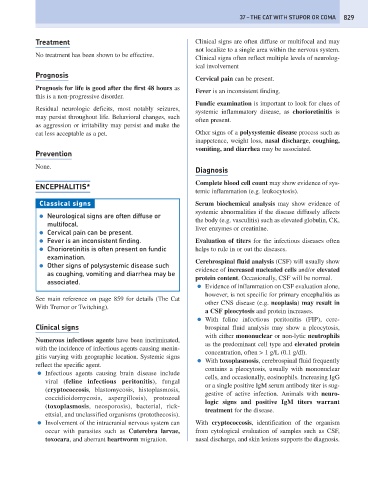Page 837 - Problem-Based Feline Medicine
P. 837
37 – THE CAT WITH STUPOR OR COMA 829
Treatment Clinical signs are often diffuse or multifocal and may
not localize to a single area within the nervous system.
No treatment has been shown to be effective.
Clinical signs often reflect multiple levels of neurolog-
ical involvement
Prognosis
Cervical pain can be present.
Prognosis for life is good after the first 48 hours as
Fever is an inconsistent finding.
this is a non-progressive disorder.
Fundic examination is important to look for clues of
Residual neurologic deficits, most notably seizures,
systemic inflammatory disease, as chorioretinitis is
may persist throughout life. Behavioral changes, such
often present.
as aggression or irritability may persist and make the
cat less acceptable as a pet. Other signs of a polysystemic disease process such as
inappetence, weight loss, nasal discharge, coughing,
vomiting, and diarrhea may be associated.
Prevention
None.
Diagnosis
Complete blood cell count may show evidence of sys-
ENCEPHALITIS*
temic inflammation (e.g. leukocytosis).
Classical signs Serum biochemical analysis may show evidence of
systemic abnormalities if the disease diffusely affects
● Neurological signs are often diffuse or
the body (e.g. vasculitis) such as elevated globulin, CK,
multifocal.
liver enzymes or creatinine.
● Cervical pain can be present.
● Fever is an inconsistent finding. Evaluation of titers for the infectious diseases often
● Chorioretinitis is often present on fundic helps to rule in or out the diseases.
examination.
Cerebrospinal fluid analysis (CSF) will usually show
● Other signs of polysystemic disease such
evidence of increased nucleated cells and/or elevated
as coughing, vomiting and diarrhea may be
protein content. Occasionally, CSF will be normal.
associated.
● Evidence of inflammation on CSF evaluation alone,
however, is not specific for primary encephalitis as
See main reference on page 859 for details (The Cat
other CNS disease (e.g. neoplasia) may result in
With Tremor or Twitching).
a CSF pleocytosis and protein increases.
● With feline infectious peritonitis (FIP), cere-
Clinical signs brospinal fluid analysis may show a pleocytosis,
with either mononuclear or non-lytic neutrophils
Numerous infectious agents have been incriminated,
as the predominant cell type and elevated protein
with the incidence of infectious agents causing menin-
concentration, often > 1 g/L (0.1 g/dl).
gitis varying with geographic location. Systemic signs
● With toxoplasmosis, cerebrospinal fluid frequently
reflect the specific agent.
contains a pleocytosis, usually with mononuclear
● Infectious agents causing brain disease include
cells, and occasionally, eosinophils. Increasing IgG
viral (feline infectious peritonitis), fungal
or a single positive IgM serum antibody titer is sug-
(cryptococcosis, blastomycosis, histoplasmosis,
gestive of active infection. Animals with neuro-
coccidioidomycosis, aspergillosis), protozoal
logic signs and positive IgM titers warrant
(toxoplasmosis, neosporosis), bacterial, rick-
treatment for the disease.
ettsial, and unclassified organisms (protothecosis).
● Involvement of the intracranial nervous system can With cryptococcosis, identification of the organism
occur with parasites such as Cuterebra larvae, from cytological evaluation of samples such as CSF,
toxocara, and aberrant heartworm migration. nasal discharge, and skin lesions supports the diagnosis.

